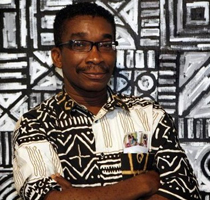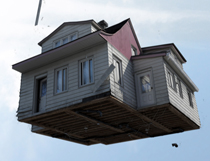A Politics of Exclusion (2)
Rikki Wemega-Kwawu
Interview with El Anatsui
Below is an excerpt of a rare interview El Anatsui granted the Art Critic Denrele Ogunwa in 1995, when he had a solo show of his work at the October Gallery in London. Anatsui took the world by storm with that exposition, which culminated in the production of his famous monologue, El Anatsui: A Sculpted History of Africa. This interview is culled from West Africa magazine, No. 4069, 9 – 15 October, 1995. (pp. 1575 – 1577), and it is captioned, “A Man of the Earth – Denrele Ogunwa talks to a foremost African Sculptor.†Relax and read on. This is what Anatsui himself has to say about his work, his inspiration and stay in Africa:
DO: This is your first solo exhibition in London?
EA: That’s true, I’ve been taking part in group shows, but this is actually my first one man exhibition.
DO: Why has it taken so long?
EA: I think it has to be the fact that if you’re an African artist based on the continent you suffer from the invisibility syndrome, unless you have some ‘godfather’ or ‘godmother’ but I have none of these, so I had to let things take their natural course.
DO: Are you saying that, no matter how well your art is, if you are based in Africa, you need contacts down here to exhibit?
EA: I’m not saying that. I am just happy that they have noticed. They are here and none of them actually goes out to know what’s happening on the continent. So it is when our work is shown in group shows that people get to know about it. If there were people coming to the continent, they would have bumped into one and helped one come and show. I have lived all my life in Africa, even though I have exhibited all over the world, that doesn’t mean that I’ve actually been to those places.
DO: What do you think of africa ’95?
EA: I think it’s a significant event. There are some concerns and flaws here and there, which are only human, But like I said early on it is difficult for people to know what is happening in the arts scene in Africa, without actually having been there. africa ’95, like all other initiatives that start from here, suffers from that syndrome. The festival is grand in scope, alright, and that is one of the challenges that it has, but they’ve managed to put something together which is somehow representative.
DO: Somehow?
EA: Somehow because like all other shows, none of them can be truly representative no matter how well they are planned.
DO: If you had the chance to arrange something like this, how would you do it?
EA: If I were to arrange something in the visual arts, I would have had graded shows. Since most of Africa has not had much exposure in the West, it is possible that few artists throughout the ages have been shown here. If we exhibited by generations (I think we can talk about up to four or five generations of African art) you can have five shows, each devoted to a separate generation, that would give people an idea of what’s going on. I think Whitechapel (the exhibition: Seven Stories About Modern Art in Africa, at Whitechapel gallery) in a way tried to do that. I would have also made sure that a lot of information is gathered about what has happened in each place before selecting the art pieces…
DO: How do you work on a typical working day?
EA: Most times I have to do a lot of thinking, decisions are really time-consuming. I’ll often spend about four out of six hours thinking about the art work before I actually started cutting.
DO: What do you think about?
EA: At the back of my mind, I think about things concerning the conditions in my environment but sometimes I simply let the medium or the process lead me on. These are the two approaches which, I guess, all artists use, with one, you attempt to impose your ideas onto the medium; with the other, the medium leads you on.
DO: Looking at some of your sculptures like, Unfolding the Scroll of History or The Ancestors Converged Again, one gets the feeling that most of your work seems to be pre-occupied with Africa’s cultural history. Why is this?
EA: If I seemed concerned with history, it is not that I want to relate history per se. I think I’m more like trying to play around, with the effects of that history or where that history is eventually consigning the continent and its people to. Rather than recounting history, my art is telling about what history has provoked.
DO: One of your works that immediately catches the eye and makes you think is the Visa Queue. Not only does it make a witty commentary, but it also holds a deeper meaning, what is it really all about?
EA: When you think about Visa Queue it’s not only a spectacle, but the ideas that it could provoke. Long ago, people were forced into migration through slavery across the Atlantic. Now, you see, apparently, no one is forcing anyone but people still want to go there and I start wondering if they are doing it on their own or maybe it’s a disguised form of that enforced migration which started so long ago. As Africans say: “there are so many ways to catch a ratâ€, either you attract it so that it comes of its own will or you put smoke in its hole, so that it will run out. I feel that the latter is happening now. The process that was initiated long ago, has turned into something like smoking out rats because the incidents of trans–Atlantic voyage and colonialism have set into motion a lot of processes which have resulted in the place (Africa) not being attractive. You find that one cannot seriously or intrinsically relate to that environment since it has been violated. So Visa Queue is not just that people are queuing for visas, but it is also trying to explain why they are queuing for visas.
DO: While we are on the topic of a violated Africa in which no one can live, several creative artists have brought up the arguments about how hard it is to create art in the atmosphere in Africa at the moment. How hard has it been for you?
EA: Art is something that is environment based. It takes its roots from a certain soil. For instance, if you take a tree that thrives in the tropics and plant it in a temperate clime, it might not survive. The same can apply to an artist. If what you derive your nurture from is not much in the new environment, you might find it difficult to create. There are some artists who have relocated and have done as well as they were doing in their origins. But it doesn’t cut across the board. It might work well for others, but not for some.
DO: Do you think it would work for you?
EA: If I moved from Africa to the West, then my orientation would have to change because you have to be concerned with what is around you. Even the media that you work with might change. I work with old mortars now, I can’t find them here! I’d probably have to work with fiberglass or bronze or some other synthetic media which I’m not attuned to. I don’t think my temperament is attuned to it because all along I’ve worked with media that are naturally found and organic like wood, clay, etc. In Africa, we are people of the earth and when I came to Nigeria I found that the Igbo among whom I’ve lived are people of the earth, too. We have “Legbaâ€, which is our earth goddess and they also have “Alaâ€, and I know that in Yorubaland also, they are people who have a lot of attachment to the earth.
DO: You’ve lived in Nigeria for 20 years but you are a Ghanaian, how have the two countries influenced your art?
EA: Most of my professional life, I’ve been in Nigeria. I did only my training and about five years teaching in Ghana. When I left Ghana, my plan was to spend three or four years in Nigeria and I ended up spending 20 years. I’ve maintained a close contact with Ghana. It’s just a 35 minute flight away. It is difficult to say that this is the Ghanaian influence or this is the Nigeria influence. Most of the time, the two of them are acting together.





No Comments so far ↓
There are no comments yet...Kick things off by filling out the form below.